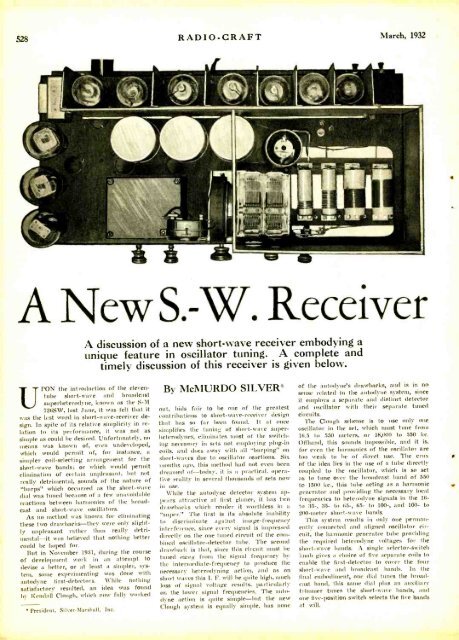Submarine Hull Is "Mike" - AmericanRadioHistory.Com
Submarine Hull Is "Mike" - AmericanRadioHistory.Com
Submarine Hull Is "Mike" - AmericanRadioHistory.Com
You also want an ePaper? Increase the reach of your titles
YUMPU automatically turns print PDFs into web optimized ePapers that Google loves.
528 RADIO -CRAFT March, 1932<br />
A New S. -W. Receiver<br />
A discussion of a new short -wave receiver embodying a<br />
unique feature in oscillator tuning. A complete and<br />
timely discussion of this receiver is given below.<br />
U1'1 A: the introduction of the eleven -<br />
tuhe short -wave and broadcast<br />
superheterodyne, known as the S -M<br />
726SW, last June, it was felt that it<br />
was the last word in short -wave-receiver design.<br />
In spite of its relative simplicity in relation<br />
to its performance, it was not as<br />
simple as could be desired. Unfortunately, no<br />
means<br />
which<br />
was known of, even undeveloped,<br />
would permit of, for instance, a<br />
simpler coil -selecting arrangement for the<br />
short -wave bands; or which would permit<br />
elimination of certain unpleasant, but not<br />
really detrimental, sounds of the nature of<br />
"burps" which occurred as the short -wave<br />
dial was tuned because of a few unavoidable<br />
reactions between harmonics of the broadcast<br />
and short -wave oscillators.<br />
As no method was known for eliminating<br />
these two drawbacks -they were only slightly<br />
unpleasant rather than really detrimental-it<br />
was believed that nothing better<br />
could be hoped for.<br />
Ilut in November 1931, during the course<br />
of development work in an attempt to<br />
devise a better, or at least a simpler, system,<br />
some experimenting was done with<br />
autodyne first -detectors. While nothing<br />
satisfactory resulted, an idea was found<br />
by Kendall Clough, which now fully worked<br />
President, Silver -Marshall, Inc.<br />
By McMURDO SILVER*<br />
out, bids fair to be one of the greatest<br />
contributions to short -wave- receiver design<br />
that has so far been found. It at once<br />
simplifies the tuning of short -wave super -<br />
heterodynes, el' ates most of the switching<br />
necessary in sets not employing plug -in<br />
coils, and dcxs away with all "burping" on<br />
short -waves due to oscillator reactions. Six<br />
months ago, this method had not even been<br />
dreamed of- today. it is it practical, operative<br />
reality in several thousands of sets now<br />
in use.<br />
While the autodyne detector system appears<br />
attractive at first glance, it has two<br />
drawbacks which render it worthless in a<br />
"super." The first is its absolute inability<br />
to discriminate against image- frequency<br />
interference, since every signal is impressed<br />
directly on the one tuned circuit of the combined<br />
oscillator- detector tube. 'l'he second<br />
drawback is that, since this circuit must be<br />
tuned awl, y from the signal frequency by<br />
the intermediate- frequency to produce the<br />
necessary heterodyning action, and as on<br />
short waves this I. F. will be quite high, much<br />
loss of signal voltage results, particularly<br />
on the lower signal frequencies. The autodyne<br />
action is quite simple -but the new<br />
Clough system is equally simple, has none<br />
of the autodvne's drawbacks, and is in no<br />
sense related to the autodyne system, since<br />
it employs a separate and distinct detector<br />
and oscillator with their separate tuned<br />
circuits.<br />
'l'he Clough scheme is to use only one<br />
oscillator in the set, which must tune front<br />
16.5 to 5.50 meters, or 18,000 to 550 ke.<br />
Offhand, this sounds impossible, and it is,<br />
for even the harmonics of the oscillator are<br />
taw weak to be of direct use. The crux<br />
of the idea lies in the use of a tube directly<br />
coupled to the oscillator, which is so set<br />
as to tune over the broadcast band of 550<br />
te 1500 kc., this tube acting as a harmonic<br />
generator and providing the necessary local<br />
frequencies to heterodyne signals in the 16-<br />
to 35 -, 3.5- to (i.5-, 65- to 100 -, and 100- to<br />
200 -meter short -wave bands.<br />
This system results in only one permanently<br />
connected and aligned oscillator drcuit,<br />
the harmonic generator tube providing<br />
the required heterodyne voltages for the<br />
short -wave bands. A single selector- switch<br />
knob gives a choice of five separate coils to<br />
enable the first -detector to cover the four<br />
short -wave and broadcast bands. In the<br />
final embodiment, one dial tunes the broadcast<br />
band, this saune dial plus an auxiliary<br />
trinuner tunes the short -wave hands, and<br />
one five- position switch selects the five hands<br />
at will.

















